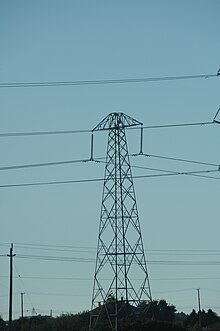| HVDC Vancouver Island | |
|---|---|
 HVDC Vancouver Island pylon | |
 Map of HVDC Vancouver Island | |
| Location | |
| Country | Canada |
| State | British Columbia |
| Coordinates | 48°49′39″N123°42′55″W / 48.82750°N 123.71528°W |
| From | Delta, British Columbia |
| To | Duncan, British Columbia |
| Ownership information | |
| Owner | BC Hydro |
| Operator | BC Hydro |
| Construction information | |
| Installer of substations | ASEA |
| Commissioned | Pole 1: 1968 Pole 2: 1977 |
| Decommissioned | Pole 1: 2014 Pole 2: 2016 |
| Technical information | |
| Type | Multi-terminal |
| Type of current | HVDC |
| Total length | 75 km (47 mi) |
| Power rating | 370 MW |
| DC voltage | 280 kV |
HVDC Vancouver Island is a de-energized high-voltage direct current interconnection owned by BC Hydro that runs between Arnott Substation (ARN) in Delta, British Columbia at 49°5′31″N123°2′31″W / 49.09194°N 123.04194°W on the Canadian mainland, and the Vancouver Island Terminal (VIT) in Duncan, British Columbia on Vancouver Island at 48°49′39″N123°42′55″W / 48.82750°N 123.71528°W . It went into operation in 1968 and was extended in 1977. HVDC Vancouver Island consists of three overhead line sections with a total length of 42 kilometres and two submarine cable sections with a length of 33 kilometres. Pole 1 ceased operation in 2014, and Pole 2 ceased operation in 2016. The infrastructure remains in place and portions may be re-used in the future.